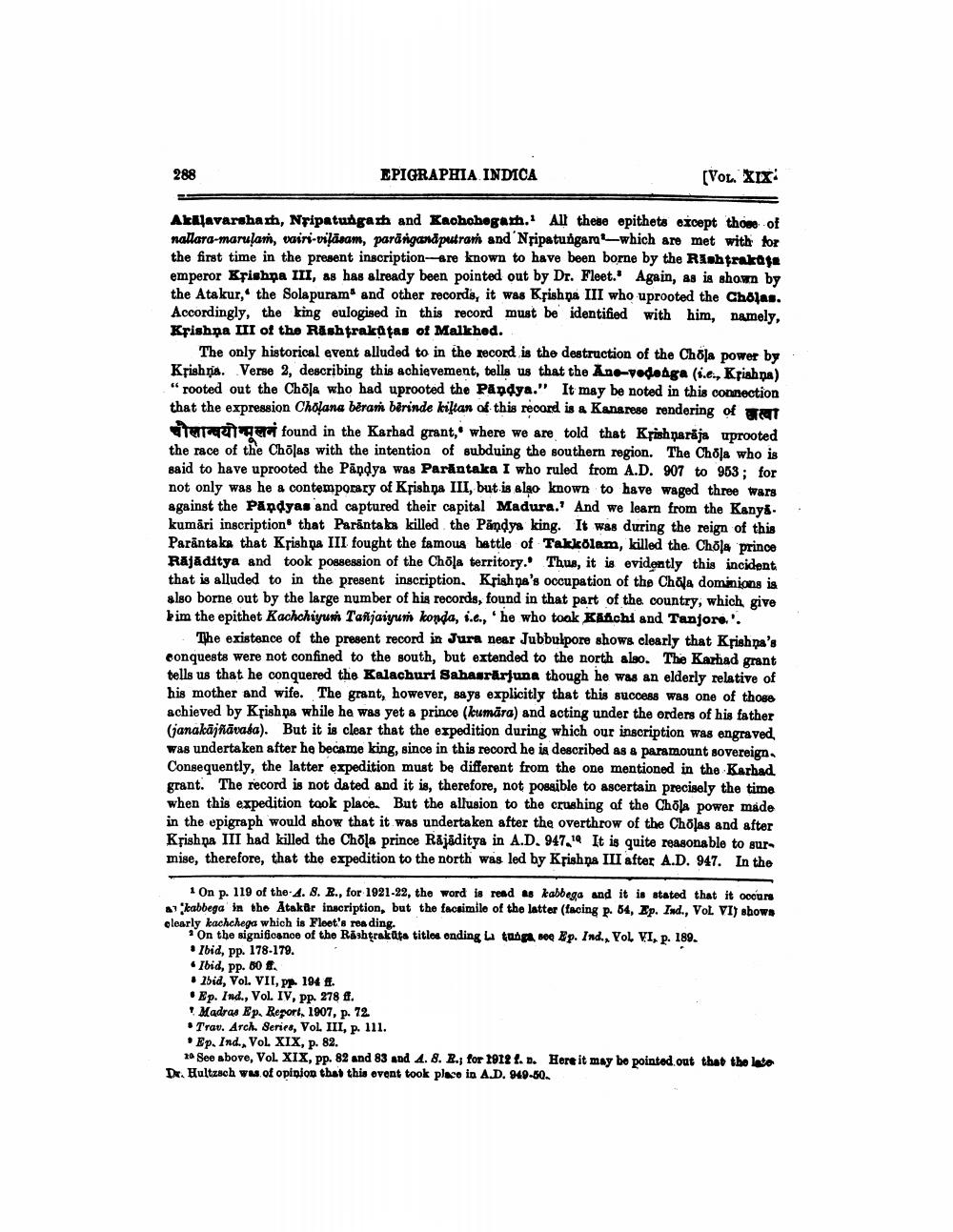________________
288
EPIGRAPHIA INDICA
(VOL. XIX
Akalavarsham, Nripatungath and Kachchegam. All these epithets except those of nallara-marulam, vairi-viļāsam, parängandputra and Nripatungan_which are met with for the first time in the present inscription are known to have been borne by the Rishtrakasa emperor Krishna III, as has already been pointed out by Dr. Fleet.' Again, as is shown by the Atakur, the Solapuram and other records, it was Krishna III who uprooted the Cholas. Accordingly, the king eulogised in this record must be identified with him, namely, Krishna III of the Rashtrakafas of Malkhed.
The only historical event alluded to in the record is the destruction of the Chola power by Krishna. Verse 2, describing this achievement, tells us that the Ano-vodonga (i.e., Krishna) “rooted out the Chola who had uprooted the Pandya." It may be noted in this connection that the expression Chalana berani berinde kiltan of this record is a Kanarese rendering of wat
Tar g ar found in the Karhad grant, where we are told that Krishnaraja uprooted the race of the Chõlas with the intention of subduing the southern region. The Chola who is said to have uprooted the Pandya Was Parāntaka I who ruled from A.D. 907 to 963; for not only was he a contemporary of Krishna III, but is alạo known to have waged three wars against the Pandyas and captured their capital Madura.' And we learn from the Kanys. kumari inscription that Parantaka killed the Pandya king. It was during the reign of this Parantaka that Krishna III fought the famous battle of Takkolam, killed the Chola prince Rajaditya and took possession of the Chola territory. Thus, it is evidently this incident that is alluded to in the present inscription, Krishna's occupation of the Chola dominions is also borne out by the large number of his records, found in that part of the country, which give bim the epithet Kachchiyuki Tafijaiyur konda, i.e.,' he who took Kanchi and Tanjore'.
The existence of the present record in Jura near Jubbulpore shows clearly that Krishna's conquests were not confined to the south, but extended to the north also. The Karhad grant tells us that he conquered the Kalachuri Sahasrarjuna though he was an elderly relative of his mother and wife. The grant, however, says explicitly that this success was one of those achieved by Krishna while he was yet a prince (kumāra) and acting under the orders of his father (janakājslāvasa). But it is clear that the expedition during which our inscription was engraved was undertaken after he became king, since in this record he is described as a paramount sovereign Consequently, the latter expedition must be different from the one mentioned in the Karbad grant. The record is not dated and it is, therefore, not possible to ascertain precisely the time when this expedition took place. But the allusion to the crushing of the Chola power made in the epigraph would show that it was undertaken after the overthrow of the Cholas and after Krishna III had killed the Chola prince Rajaditya in A.D. 947,1 It is quite reasonable to surmise, therefore, that the expedition to the north was led by Krishna III after A.D. 947. In the
1 On p. 119 of the 4. 8. R., for 1921-22, the word is read as kabbega and it is stated that it oocun
kabbega in the Atakör inscription, but the facsimile of the latter (facing p. 54, Ep. Ind., VOL VI) shows clearly kachchega which is Fleet's reading.
* On the significance of the Rashtrakata titles ending La tanga soe Ep. Ind., YOL VI, p. 189.
Ibid, pp. 178-179. • Ibid, pp. 80 E. • Zbid, Vol. VII, pp. 194 ft. • Ep. Ind., Vol. IV, Pp. 278 ff.
Madras Ep. Report, 1907, p. 72. • Trav. Arch. Series, VOL III, p. 111.
Ep. Ind., VOL XIX, p. 82. 2* See above, Vol XIX, pp. 82 and 83 and 4. 8. B.; for 1912 1. 1. Here it may be pointed out that the lato Dr. Hultzach wm of opinion that this event took place in A.D. 949-50




